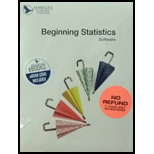
To find:
To perfom the test statistic for the following scenerio,
“A school principal claims that the number of students who are tardy in her school does not vary from month to month. Using a 0.05 level of significance, test a teacher’s claim that the number of tardy studens does vary by the month”.
Answer to Problem 21E
Solution:
(a)
(b) The chi-square test for this goodness of fit and the level of siginificance is
(c) The test statistic value is
(d) There is no sufficient evidence to support the teacher’s claim that the number of tardy students does vary by the month.
Explanation of Solution
The following table represents the random sample of number of students who are tardy in her school is,
| Tardy Students | ||||||||||
| Aug. | Sept. | Oct. | Nov. | Dec. | Jan. | Feb. | Mar. | Apr. | May | |
| Number | 7 | 18 | 16 | 5 | 8 | 12 | 15 | 18 | 11 | 15 |
Step 1: To state the null and alternative hypotheses.
When starting the hypotheses to be used we take the null hypothesis to be that the proportion of students who are tardy in her school does not vary from month to month.
Null hypothesis:
Alternative hypothesis:
Mathematically, we can write the null and alternative hypothesis as follows,
Step 2: To determine whether the observed values of tardy students match with the
Step 3: To calculate the test statistic.
Let‘s calculate the expected value for each month of the year. Since we are assuming that the number of tardy students does not vary for each month, then the probability will be same for every day, so expected number of students for each month is calculated as follows,
And,
Formula for calculating test statistic for a Chi-Square test for goodness of fit:
The test statistic for a chi-square test for goodness of fit is given below,
Where Oi, is the observed frequency for the ith possible outcome and Ei is the expected frequency for the ith possible outcome and n is the sample size.
From the above table represent the value of n is 125.
The following table represents the test statistic,
| Month | Observed Values | Expected values | |||
| Aug. | 7 | 12.5 | -5.5 | 30.25 | 2.42 |
| Sept. | 18 | 12.5 | 5.5 | 30.25 | 2.42 |
| Oct. | 16 | 12.5 | 3.5 | 12.25 | 0.98 |
| Nov. | 5 | 12.5 | -7.5 | 56.25 | 4.5 |
| Dec. | 8 | 12.5 | -4.5 | 20.25 | 1.62 |
| Jan. | 12 | 12.5 | -0.5 | 0.25 | 0.02 |
| Feb. | 15 | 12.5 | 2.5 | 6.25 | 0.5 |
| Mar. | 18 | 12.5 | 5.5 | 30.25 | 2.42 |
| Apr. | 11 | 12.5 | -1.5 | 2.25 | 0.18 |
| May | 15 | 12.5 | 2.5 | 6.25 | 0.5 |
Step 4: Degrees of freedom in a Chi-square test for goodness of fit:
In a chi-square test for goodness of fit the number of degrees of freedom for the chi-square distribution of the test statistic is given by,
Where k is the number of possible outcomes for each trial.
Rejection Region for Chi-Square Test for Association:
Reject the null hypothesis,
From the given information k = 10.
Substitute the above values in the formula of degrees of freedom to get the following,
Conclusion:
Use the level of significance of
Use the “Area to the right of the critical value
The test statistic value is
By using the above condition we fail to reject the null hypothesis.
Since
So, there is no sufficient evidence to support the teacher’s claim that the number of tardy students does vary by the month.
Final statement:
(a)
(b) The chi-square test for this goodness of fit and the level of siginificance is
(c) The test statistic value is
(d) There is no sufficient evidence to support the teacher’s claim that the number of tardy students does vary by the month.
Want to see more full solutions like this?
Chapter 10 Solutions
BEGINNING STATISTICS-CD (NEW ONLY)
 MATLAB: An Introduction with ApplicationsStatisticsISBN:9781119256830Author:Amos GilatPublisher:John Wiley & Sons Inc
MATLAB: An Introduction with ApplicationsStatisticsISBN:9781119256830Author:Amos GilatPublisher:John Wiley & Sons Inc Probability and Statistics for Engineering and th...StatisticsISBN:9781305251809Author:Jay L. DevorePublisher:Cengage Learning
Probability and Statistics for Engineering and th...StatisticsISBN:9781305251809Author:Jay L. DevorePublisher:Cengage Learning Statistics for The Behavioral Sciences (MindTap C...StatisticsISBN:9781305504912Author:Frederick J Gravetter, Larry B. WallnauPublisher:Cengage Learning
Statistics for The Behavioral Sciences (MindTap C...StatisticsISBN:9781305504912Author:Frederick J Gravetter, Larry B. WallnauPublisher:Cengage Learning Elementary Statistics: Picturing the World (7th E...StatisticsISBN:9780134683416Author:Ron Larson, Betsy FarberPublisher:PEARSON
Elementary Statistics: Picturing the World (7th E...StatisticsISBN:9780134683416Author:Ron Larson, Betsy FarberPublisher:PEARSON The Basic Practice of StatisticsStatisticsISBN:9781319042578Author:David S. Moore, William I. Notz, Michael A. FlignerPublisher:W. H. Freeman
The Basic Practice of StatisticsStatisticsISBN:9781319042578Author:David S. Moore, William I. Notz, Michael A. FlignerPublisher:W. H. Freeman Introduction to the Practice of StatisticsStatisticsISBN:9781319013387Author:David S. Moore, George P. McCabe, Bruce A. CraigPublisher:W. H. Freeman
Introduction to the Practice of StatisticsStatisticsISBN:9781319013387Author:David S. Moore, George P. McCabe, Bruce A. CraigPublisher:W. H. Freeman





